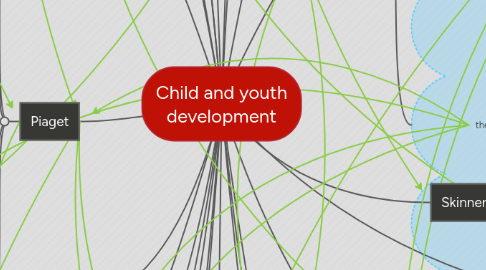
1. ELA
1.1. literacy
1.1.1. functional
1.1.2. cultural
1.1.3. progressive
1.1.4. critical literacy
1.2. pre-reading
1.3. aesthetic stance
1.3.1. experienced based
1.3.2. sensations
1.3.3. feelings
1.4. efferent stance
1.4.1. what is to be derived from a reading
1.4.2. details
1.4.3. directions
1.4.4. information
1.5. writing
1.5.1. communicate ideas
1.5.2. reflect personal views
1.5.3. entertain
2. Art
3. Summative assessment
3.1. quantitative
4. Formative assessment
4.1. qualitative
4.2. New B.C. curriculum
5. Zone of Proximal Development
5.1. scaffolding questions
6. Inquiry Questions
6.1. case based learning
7. looking through a lens
7.1. developmental lens
8. Piaget
8.1. Developmental stages
8.2. stage based theory
8.3. equilibrium learning
8.4. 2 stage model
8.4.1. prior knowledge provides basis for new knowledge
9. Erickson
9.1. developmental crisis
9.2. trust vs. mistrust
10. Tech
10.1. flow experience
10.1.1. Mihalyi Csikszentmihalyi
10.2. technology integration
11. Risk Factors
11.1. lack of role models
11.2. early development
11.3. trying to fit in with peer group
12. Risky play
12.1. maturity levels
12.1.1. some girls don't exhibit risky play
12.2. can have long term positive effects for children
12.2.1. exploring
12.3. can have long term negative effects for adults
12.4. Risky behaviour to fit in with the family are not as risky as risky behaviours exhibited to fit in with your peer group
13. protective factors
13.1. having a peer group
13.2. having positive role models
13.3. voicing concerns about things such as pop culture in the classroom
14. moral development
14.1. • “How humans cooperate and coordinate their activities in the service of further human welfare and how they adjudicate conflicts among individual differences”
15. Kohlberg: Moral Reasoning Measure
15.1. stage A: 1. Fear of punishment – 2. personal reward (pre-conventional stage)
15.2. Stage B. 3. Good/nice – 4. law and order (conventional stage) – belief of conformity to expectations of others leading to acceptance and approval (good/nice) – both are heteronomous reasoning
15.3. •Stage C. 5. Social contract – 6. abstract principles (post-conventional stage) – it is ok to challenge the “system” and laws, humans can bring about change
15.4. believed not many people made it to 5. or 6.
15.5. Carol Gilligan
15.5.1. •student of Kohlberg – believed that this was a very male focused, gender biased way of thinking about moral reasoning.
16. Math
16.1. project-based learning
17. Science
17.1. guided disovery
18. Skinner
18.1. positive reinforcement
18.2. negative reinforcement
18.3. student needs to know exactly what you want them to do
18.4. intermittent reinforcement
18.5. punishment will stop a behaviour but will not change it
19. Bloom's Taxonomy
19.1. hierarchy of classifying learning objectives
19.2. assessment
20. Using Humour
20.1. zone of benign violation
20.1.1. context
20.1.2. culture
20.2. abstract
20.3. reality
21. communication
21.1. non-verbal
21.1.1. body language
21.1.2. empathy
21.1.3. proximity
21.2. verbal
21.3. language
21.4. theory of mind
21.4.1. Selman
21.4.2. social awareness
21.4.3. making sense of social behaviour
21.4.4. making sense of feelings/emotions
21.4.5. making sense of communication
21.4.6. confabulation
22. physical development
22.1. taking notes
22.2. early/late maturity and risk factors
22.3. resiliency
23. learning
23.1. personal reflection
23.2. risk factors
24. mental development
24.1. early/late maturity and risk factors
25. Relational vs Physical bullying
25.1. girls tend to exhibit relational bullying, boys physical
25.2. resiliency approach
25.2.1. reduce risk, increase protection
25.2.2. includes risk factors and protective factors
25.2.2.1. risk factors and protective factors not necessarily opposites
